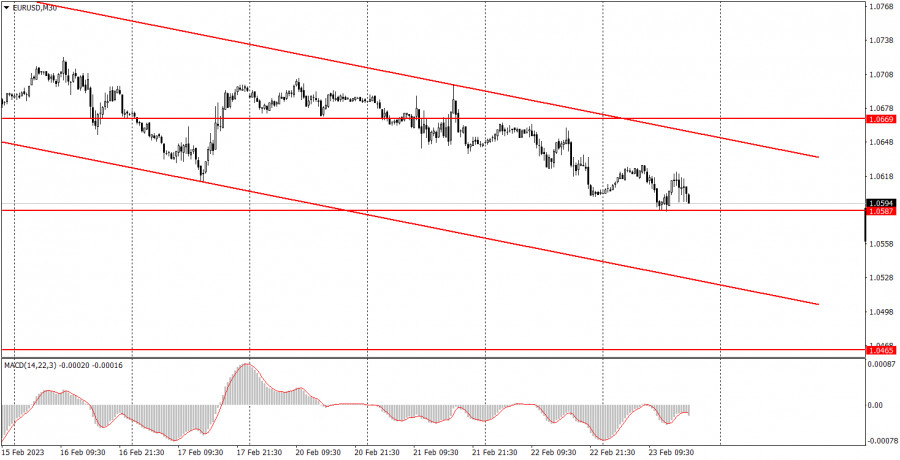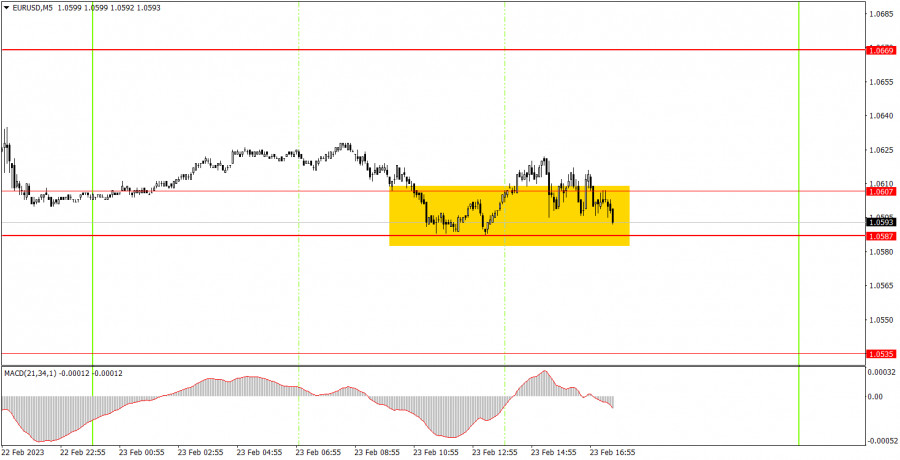

EUR/USD continued to fall on Thursday and ended up near 1.0587. As I mentioned in our previous articles, the pair is moving down quite weakly, losing an average of 20-30 pips a day, and not every day. But on the other hand, now it is difficult to expect a strong move, because there is almost no fundamental and macroeconomic background. What have we got on Thursday? One EU inflation report for January in the second estimate? The total volatility of the day was about 40 points at this point. That's all there is to know about how the market reacted to the "important" inflation report. And I already warned you that the market won't find the second estimate interesting. The EU currency continues to fall as the likelihood of more aggressive monetary tightening by the Fed in 2023 continues to grow. This is evidenced by Wednesday's Federal Reserve minutes and some of the Fed members who have been interviewed recently. On the 30-minute chart, we now have a descending channel, which provides a clear indication of a possible decline and an understanding of when that decline may end.
EUR/USD on 5M chart
We can't talk about Thursday's trading signals. I mean, what is there to talk about if the pair shows volatility of 40 pips? Either the signals are false, or there are none. So, during the middle of the European session, the pair reached the range of 1.0587-1.0607 and it spent almost the entire day in this 20-point range. It only briefly left that range in the US session, which novice traders could consider as a buy signal. Of course, this signal turned out to be false, but at the moment, it is not even cancelled, because there is no sell signal. As a result, beginners could close this trade with a minimum, purely formal loss. This week's volatility and movements were not pleasing.
Trading tips on Friday:On the 30-minute chart, the pair as a whole maintains the downtrend, but the movement is now weak, with frequent corrections. Such movement is very difficult to work out. Volatility fell and there won't be much news and reports in the near future. In general, we can expect a few boring weeks. On the 5-minute chart, it is recommended to trade at the levels 1.0535, 1.0587-1.0607, 1.0669, 1.0697, 1.0792, 1.0857-1.0867. As soon as the price passes 15 pips in the right direction, you should set a Stop Loss to breakeven. Friday will release U.S. personal income and spending reports and the University of Michigan's consumer sentiment index. Absolutely secondary reports, and the market will only react to these reports if results sharply deviate from forecasts. I don't think we will see any strong moves on the final day of the week. The pair might even edge up a bit after a few days of declines.
Basic rules of the trading system:1) The strength of the signal is determined by the time it took the signal to form (a rebound or a breakout of the level). The quicker it is formed, the stronger the signal is.
2) If two or more positions were opened near a certain level based on a false signal (which did not trigger a Take Profit or test the nearest target level), then all subsequent signals at this level should be ignored.
3) When trading flat, a pair can form multiple false signals or not form them at all. In any case, it is better to stop trading at the first sign of a flat movement.
4) Trades should be opened in the period between the start of the European session and the middle of the US trading hours when all positions must be closed manually.
5) You can trade using signals from the MACD indicator on the 30-minute time frame only amid strong volatility and a clear trend that should be confirmed by a trendline or a trend channel.
6) If two levels are located too close to each other (from 5 to 15 pips), they should be considered support and resistance levels.
On the chart:Support and Resistance levels are the levels that serve as targets when buying or selling the pair. You can place Take Profit near these levels.
Red lines are channels or trend lines that display the current trend and show in which direction it is better to trade now.
The MACD indicator (14, 22, and 3) consists of a histogram and a signal line. When they cross, this is a signal to enter the market. It is recommended to use this indicator in combination with trend patterns (channels and trendlines).
Important announcements and economic reports that can be found on the economic calendar can seriously influence the trajectory of a currency pair. Therefore, at the time of their release, we recommend trading as carefully as possible or exiting the market in order to avoid sharp price fluctuations.
Beginners on Forex should remember that not every single trade has to be profitable. The development of a clear strategy and money management is the key to success in trading over a long period of time.